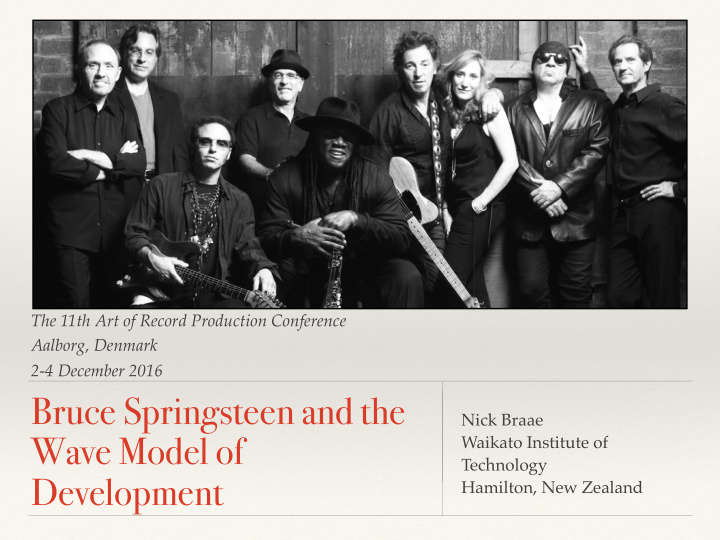



The 11th Art of Record Production Conference Aalborg, Denmark 2-4 December 2016 Bruce Springsteen and the Nick Braae Wave Model of Waikato Institute of Technology Development Hamilton, New Zealand
Springsteen, Criticism, and the Discourse of Evolution ❖ Wrecking Ball (2012): “few, if any, moments of musical innovation here” (Gill, The Telegraph ); ❖ “It] finds Springsteen still firing on all cylinders—writing with poetic urgency, drawing on traditions old and new, singing and playing with prime strength and energy, and delivering a new set of killer melodies with fresh sonic wallop” (Leftridge, PopMatters ) ❖ “Just for a change it’s encouraging to hear a big sound that’s linked not to individual aggrandizement or indulgence, but to something more unselfish…It also…holds some of Springsteen’s most elaborate studio concoctions since ‘Born to Run’” (Paraeles and Caramanica, New York Times ) ❖ “[M]usically Wrecking Ball is the most innovative album of Springsteen’s career…” (Masur, PopMatters )
Musical Development and Popular Music Historiography ❖ Braae (2014): analysis of Queen’s musical development, 1973-80; focus on identifying and understanding musical changes over time ❖ “Expedition” narrative and Queen (Braae 2014); “elliptical” model and Radiohead (Moore and Ibrahim 2009) ❖ The “wave” model and Springsteen
Born to Run (1975) ❖ “Wall-of-sound” style production (Zagorski-Thomas 2010) ❖ Droning saxophone of “Born to Run” cf. The Ronette’s “Do I Love You?” or Ike and Tina Turner’s “River Deep, Mountain High”; glockenspiel like Darlene Love’s “The Boy I’m Gonna Marry” ❖ Stratification of texture: dense middle-low register (bass, acoustic/electric guitars) plus sparkling upper register keyboards
“She’s the One” and “Thunder Road”
“Darkness on the Edge of Town”, “I’m a Rocker”, “Ramrod”
Born in the USA ❖ Textural stasis (aligning with limited harmonic movement) ❖ Various layers—bass guitar, electric guitars, keyboards —converge into single harmonic layer; limited counter- melodic embellishments
“Born in the USA”
Born in the USA ❖ Textural stasis (aligning with limited harmonic movement) ❖ Various layers—bass guitar, electric guitars, keyboards —converge into single harmonic layer; limited counter- melodic embellishments
“Walk Like a Man”, “Living Proof”
The Rising -present ❖ Additions to the backing band: backing vocal sections (gospel choir); strings and/or horns; extra organs (beyond Hammond) ❖ Active, swirling, and dense middle register, but also the return of stratified upper layers (piano/organ)
“Mary’s Place”
The Rising -present ❖ Additions to the backing band: backing vocal sections (gospel choir); strings and/or horns; extra organs (beyond Hammond) ❖ Active, swirling, and dense middle register, but also the return of stratified upper layers (piano/organ)
“I’ll Work For Your Love”, “Gypsy Biker”
Springsteen and Record Production Historiography ❖ A cyclical model? ❖ The wave model: phases of sonic signatures ❖ Reflects continuities across eras (e.g. “The Wrestler” (2009) and 1980s style), analogous to water washing back out to sea ❖ Lack of fixed evolutionary points over time, so much as retrospective identification of “breaking” and continuity ❖ Little sense of linear evolution; emphasis on change and renewal
The Outliers ❖ Nebraska (1982); The Ghost of Tom Joad (1995); Devils and Dust (2005) ❖ Stripped-back acoustic sound; outside major waves of Springsteen’s career ❖ Or…necessary stylistic ruptures in Springsteen’s narrative ❖ “Productive tension” between modernist and folk visions of Romanticism (Keightley 2001)
Recommend
More recommend